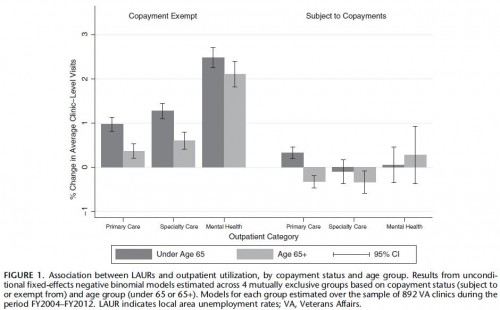Edwin Wong and colleagues examined the association between unemployment rates and use of outpatient services in the Veterans Health Administration (VA) between 2004 and 2012.
Prior studies have identified a negative relationship between unemployment rates and utilization of both inpatient and outpatient health services among individuals under age 65. Specifically, higher unemployment rates were associated with decreases in discretionary health services including preventative medical services and routine nonemergency medical care. In contrast, 2 notable studies examining Medicare-eligible seniors found rates of hospitalization increased as unemployment rates rose. McInerney and Mellor attribute this finding, in part, to increased supply resulting from a greater willingness of providers to accept Medicare-eligible patients.
Wong et al.’s findings are somewhat different. Their results, after adjusting for season, a time trend, time-invariant clinic fixed effects, as well as VA clinic-level demographic, provider, and patient characteristics, are shown in the figure below. The bars show the percent change in average clinic-level visits associated with a one percentage point change in local area unemployment rate.
Among veterans exempt from copayments, unemployment rates are positively and statistically significantly correlated with VA primary, specialty, and mental health care, for both those under 65 and 65+. It’s reasonable to presume non-elderly veterans lose jobs and insurance coverage as the unemployment rate rises. Their greater utilization underscores the VA’s role as a safety net.
It’s a bit harder to explain why utilization of the 65+, copay exempt population also rose in association with unemployment rates. I didn’t catch an explanation in the paper, and, though I could speculate, I don’t have an evidence-based explanation.
Patterns of use for veterans subject to copayments were different, as shown. (Find VA copayment details here.) With the exception of primary care use for those under 65, utilization is either negatively associated with unemployment rates or not statistically significant. The large difference in utilization patterns between the copayment exempt and non-exempt groups underscores the role copayments play in access to care.



